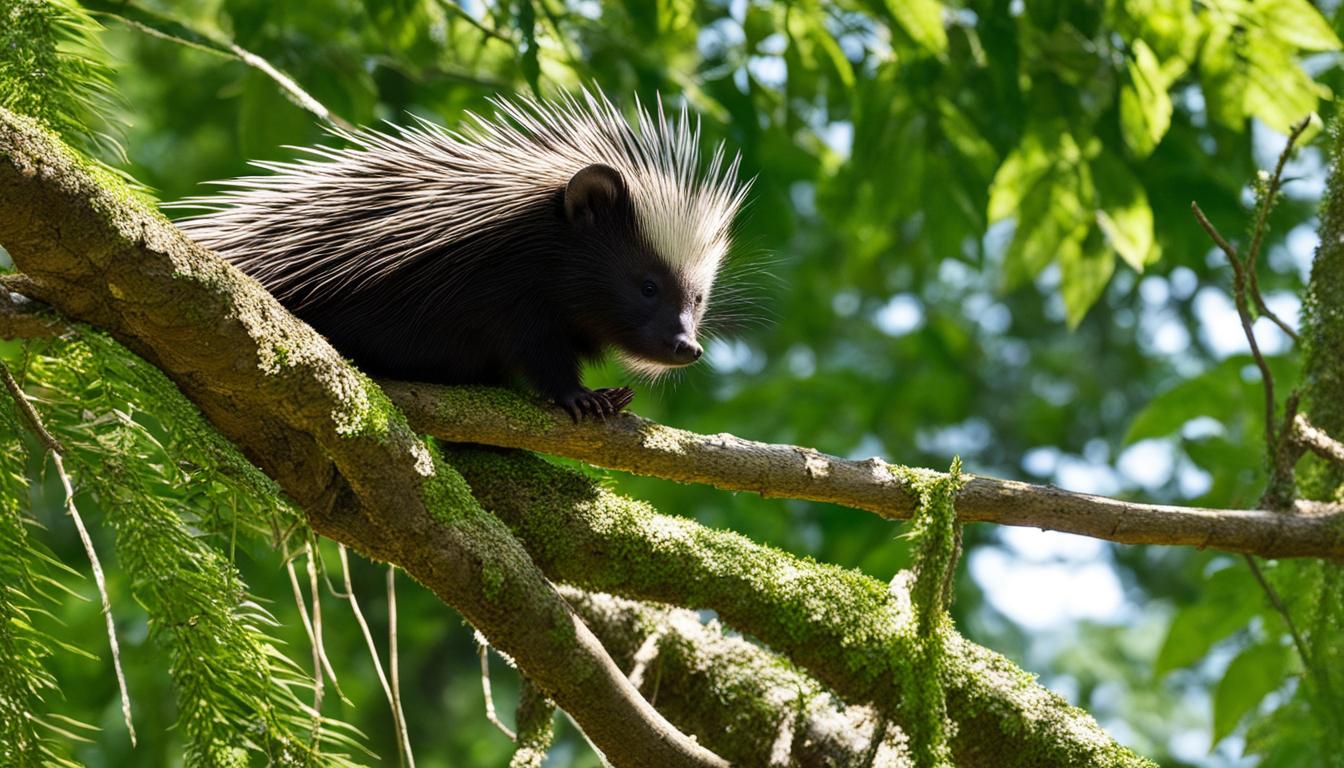Have you ever wondered if porcupines roam the forests of Wisconsin?
The answer is a resounding yes! According to various sources, including Wisconsin Natural Resources magazine, porcupines can be found in the state. Specifically, the common porcupine (Erethizon dorsatum) is present in the northern two-thirds of Wisconsin, spanning a wide area from Pierce County to Wisconsin Dells and up towards Green Bay.
These fascinating creatures, weighing around 30 pounds in summer, are the second-largest rodent in Wisconsin, surpassed only by the North American beaver.
They primarily inhabit coniferous or deciduous forests, blending in seamlessly with their surroundings.
Porcupines play an important role in the ecosystem, though they can occasionally cause nuisance situations for property owners.
Let’s delve deeper into their habitat, behavior, and how to manage encounters with them in Wisconsin.
Key Takeaways:
- Porcupines are indeed present in Wisconsin, particularly in the northern two-thirds of the state.
- They can be found in a variety of habitats, including coniferous and deciduous forests.
- Porcupines primarily feed on plants, tree bark, and other vegetation.
- While generally docile, they have a natural defense mechanism in the form of sharp quills.
- Porcupines can create nuisance situations by damaging trees and garden plants.
Porcupine Habitat and Behavior in Wisconsin
Porcupines in Wisconsin can be found in a variety of habitats, but they primarily inhabit forests.
Specifically, they are known to reside in areas with conifer trees such as pines, hemlock, spruce, and firs, as well as deciduous trees like maples and birch.
These forests provide the porcupines with the necessary food and shelter.
Porcupines have a winter diet consisting of conifer needles, buds, and bark. This helps them survive during the colder months when other food sources may be scarce.
In spring and summer, they switch to consuming tender shoots, twigs, roots, and seeds. However, it’s important to note that porcupines are not solely herbivores.
They have been known to feed on garden plants, fruits, and vegetables, which can sometimes cause nuisance situations for property owners.
Porcupines in Wisconsin are primarily nocturnal, meaning they are most active during the night. They are solitary creatures, but during the winter, they may den together in groups to keep warm.
During the mating season, they form temporary social groups. These behaviors contribute to their adaptation and survival in the Wisconsin wilderness.
Promoting Coexistence with Porcupines
Understanding the habitat and behavior of porcupines in Wisconsin is crucial for promoting coexistence.
Property owners can take measures to prevent porcupine-related issues. This includes removing artificial food sources like pet food, garbage, and compost, as well as protecting vulnerable crops and ornamental plants with fences or physical barriers.
If necessary, live traps or lethal traps can be used to capture or remove porcupines, following appropriate trapping regulations.
It’s important to handle quilled porcupines with care to avoid injuries from their sharp quills. Seeking medical attention for quill removal, if necessary, is recommended.
Porcupine Size and Characteristics

Porcupines in Wisconsin exhibit a range of sizes and distinctive characteristics. They typically measure between 2 to 3 feet in length and weigh around 8 to 15 pounds.
However, there have been reports of particularly large porcupines weighing up to 40 pounds. Their bodies are covered in long, sharp quills that act as a defense mechanism.
These quills are most concentrated on their backs and tails, which can be raised when the porcupine feels threatened.
The barbs on the quills make them difficult to remove once they become embedded in a predator’s skin or fur.
With their herbivorous diets, porcupines primarily feed on plants and tree bark. They have a slow, lumbering gait and tend to be most active during the night.
Rather solitary in nature, they prefer to reside in forested areas, including both coniferous and deciduous forests.
Porcupines play a vital role in the ecosystem, helping to prune trees and creating habitat for other animals.
Porcupine Adaptations
One of the most fascinating adaptations of porcupines is their quills. These quills, which can number up to 30,000 on a single porcupine, are made of keratin, the same material found in human hair and nails.
When threatened, a porcupine will raise its quills and may even stamp its feet or make warning sounds to deter predators.
The quills are barbed, and they detach easily upon contact, making it difficult for predators to remove them without sustaining painful injuries.
While porcupines are primarily peaceful animals, it’s important to keep a safe distance and avoid any unnecessary interactions to prevent accidental quill injuries.
Porcupine Population and Distribution in Wisconsin

Porcupines are widely distributed throughout the northern two-thirds of Wisconsin, making them a common sight in the state’s forested areas.
These fascinating creatures have adapted well to the diverse habitats found in Wisconsin, from remote wilderness regions to suburban and urban environments.
Whether you’re exploring the wilderness or simply taking a walk in a nearby park, you may come across a porcupine if you keep your eyes open.
Porcupine populations can vary within their range, but they are most commonly found in forested areas with a mix of coniferous and deciduous trees.
It’s not unusual to spot them in areas with pines, hemlocks, spruce, firs, maples, and birch trees. These environments provide the porcupines with plentiful food sources, including conifer needles, buds, bark, tender shoots, twigs, roots, and seeds.
To get a glimpse of these remarkable creatures, it’s best to visit their preferred habitats during the winter when their food sources are limited.
Porcupines tend to be more active during this time, and their presence may be more noticeable as they venture out in search of sustenance.
Keep in mind that porcupines are primarily nocturnal and solitary animals, so observing them can be a rare treat.
Porcupine Population and Distribution
Porcupines in Wisconsin have established a stable and widespread population, making the state an ideal place for wildlife enthusiasts to spot these unique creatures.
From their slow and lumbering gait to their quill-covered bodies, porcupines are a fascinating species that plays an important role in Wisconsin’s forest ecosystems.
Next, we will take a closer look at the behavior and interactions of porcupines in Wisconsin, shedding light on their docile nature and natural defense mechanisms.
Porcupine Behavior and Interactions in Wisconsin
Porcupines in Wisconsin display fascinating behavior and have unique interactions with their environment.
While they are generally docile and non-aggressive towards humans, they possess a natural defense mechanism that sets them apart.
When threatened, a porcupine will face away from its enemy, raise its quill-studded tail, and emit warning sounds.
This behavior serves as a deterrent for potential predators and curious animals, as the porcupine’s sharp quills can easily detach upon contact, causing painful injuries.
It’s important to note that porcupines in Wisconsin can coexist with humans peacefully. However, interactions should be approached with caution and respect for their personal space.
Avoiding direct contact and giving them ample room to retreat is the best way to ensure a positive encounter.
The Role of Porcupines in Creating Habitat
Despite their defense mechanisms, porcupines actually play a crucial role in creating habitat for other animals.
As they feed on trees, their gnawing behavior can create snags, or standing dead trees, which provide nesting sites for birds and shelter for various wildlife species.
This unique interaction between porcupines and their environment contributes to the overall biodiversity and ecological balance in Wisconsin’s forests.
While porcupines may cause damage to trees through their feeding habits, it’s important to remember that they are simply fulfilling their role in the ecosystem.
Understanding and appreciating these interactions allows us to coexist with porcupines and maintain the delicate balance of nature in Wisconsin.
Porcupine Nuisance Situations in Wisconsin

While porcupines in Wisconsin are generally docile and non-aggressive towards humans, they can sometimes create nuisance situations for property owners.
One common issue is the damage they can cause to trees. Porcupines have a habit of gnawing on the bark of trees, which can lead to the death of the tree if the damage is severe enough.
This can be particularly concerning for homeowners and those who own wooded properties.
In addition to tree damage, porcupines may also be a source of frustration for gardeners. They have been known to feed on garden plants, fruits, and vegetables, which can lead to significant losses in crops.
This behavior can be particularly problematic in areas where porcupines are abundant.
Porcupines can also cause damage to structures. They may chew on exposed wood on houses or sheds, especially if there is salt in the wood.
In harsh weather conditions, porcupines may seek shelter in attics or barns, leading to potential damage and nuisance situations for property owners.
The Importance of Handling Porcupines with Caution
It is worth noting that while porcupines in Wisconsin do not carry many diseases of concern to humans, they should still be handled with caution.
Porcupines have sharp quills that can detach easily upon contact, causing painful injuries to both predators and curious animals that get too close.
If you encounter a porcupine, it is best to keep a safe distance and avoid any potential quill injuries.
In cases where porcupines are causing significant damage or posing a threat to property, it may be necessary to implement management strategies to mitigate these nuisance situations.
This can include removing potential food sources, securing property to prevent access, and utilizing appropriate trapping methods to capture or remove porcupines, following local regulations.
Managing Porcupine Encounters in Wisconsin

Encountering porcupines in Wisconsin can be an interesting experience, but it is important to know how to manage these encounters to ensure the safety of both humans and the porcupines themselves.
Here are some tips for managing porcupine encounters in Wisconsin.
Understanding Porcupine Behavior
Porcupines in Wisconsin are generally docile and non-aggressive towards humans. However, they possess a natural defense mechanism in the form of sharp quills.
When threatened, a porcupine will face away from its enemy, raise its quill-studded tail, and emit warning sounds.
It is essential to give porcupines plenty of space and avoid approaching them. If you encounter a porcupine, calmly and slowly back away to minimize the risk of quill injuries.
Preventing Porcupine Access
To prevent porcupines from causing damage on your property, it is important to remove potential food sources and secure your premises.
Porcupines are attracted to food such as pet food, garbage, and compost. By eliminating these artificial food sources, you can discourage porcupines from coming near your property.
Additionally, protecting vulnerable plants and trees with fences or other physical barriers can help prevent porcupines from causing damage through their feeding habits.
Fixing any holes or vulnerable areas in buildings can also prevent porcupines from entering and seeking shelter.
Proper Trapping and Removal
If necessary, live traps or lethal traps can be used to capture or remove porcupines. However, it is important to follow the appropriate trapping regulations and guidelines set by local authorities.
Porcupines should be handled with caution, as their quills can detach easily and cause painful injuries.
If you are uncertain or uncomfortable with trapping and removal, it is recommended to seek professional assistance from wildlife control experts who have the knowledge and experience to handle porcupine encounters safely and ethically.
Conclusion
In conclusion, porcupines are indeed present in Wisconsin, specifically in the northern two-thirds of the state.
These fascinating creatures, known for their distinctive appearance and impressive quills, play an important role in the forest ecosystems of Wisconsin.
While porcupines can sometimes create nuisance situations for property owners, understanding their habitat, behavior, and proper management strategies can help mitigate conflicts and promote coexistence.
By removing potential food sources, securing property, and implementing physical barriers, property owners can reduce the chances of porcupines causing damage or nuisance.
It is important to note that porcupines are generally docile and non-aggressive towards humans, but caution should be exercised to avoid quill injuries.
If necessary, live traps or lethal traps can be used to capture or remove porcupines, following appropriate trapping regulations.
Seeking medical attention for quill removal is crucial to prevent complications.
In summary, with the right knowledge and approach, it is possible to coexist with porcupines in the Wisconsin wilderness while ensuring the safety of property and humans.
By respecting their natural habitat and implementing appropriate management strategies, we can appreciate the presence of these unique creatures in the beautiful state of Wisconsin.
FAQ
Are porcupines native to Wisconsin?
Yes, porcupines, specifically the common porcupine (Erethizon dorsatum), are present in the northern two-thirds of Wisconsin.
Where can I find porcupines in Wisconsin?
Porcupines can be found in forests across Wisconsin, including areas with conifer trees such as pines, hemlock, spruce, and firs, as well as deciduous trees like maples and birch.
How big are porcupines in Wisconsin?
Porcupines in Wisconsin can range in size from 2 to 3 feet in length and weigh between 8 to 15 pounds, although there have been reports of porcupines weighing up to 40 pounds.
What do porcupines in Wisconsin eat?
Porcupines in Wisconsin have a winter diet consisting of conifer needles, buds, and bark, while in spring and summer, they consume tender shoots, twigs, roots, and seeds. They may also feed on garden plants, fruits, and vegetables.
Are porcupines in Wisconsin dangerous?
Porcupines in Wisconsin are generally docile and non-aggressive towards humans. However, they have sharp quills that can cause painful injuries if they feel threatened or are mishandled.
How can I manage porcupine encounters on my property in Wisconsin?
To manage porcupine encounters in Wisconsin, it is important to remove potential food sources, secure property to prevent access, and consider using live traps or lethal traps following appropriate regulations.




